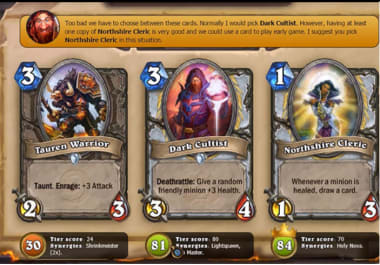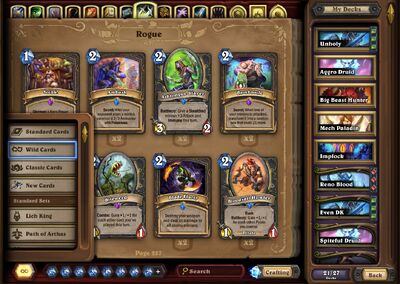- How To Change Language For Hearthstone Macros
- How To Change Language For Hearthstone Macos
- How To Change Language For Hearthstone Mac Os
- How To Download Hearthstone Pc
- Hearthstone Card Change
- Hearthstone Download Mac
- How To Change Language For Hearthstone Mac Download
The way you play HearthStone is similar to other games in this genre like Magic: The Gathering. Each turn, players will receive an additional mana point and can play as many cards as their mana permits. The creatures are for putting points down on the table and attacking your opponent's creatures (or attacking your enemy directly). The magic, on the other hand, lets you take more direct actions.
Players face off against one another in individual duels via the Internet. You can also play against the computer if you wish. The most interesting game mode is Arena, where you have to improvise with a deck of cards in the moment and try to survive as many duels as possible with it.
The most important part of HearthStone is the combat against other players, but it's not the only thing. Collecting cards is also a very important element, since players are able to buy card packs to create their own decks. To earn money to do this, you can either win battles ... or use real money.
HearthStone is an outstanding trading card game, possibly the best of its kind. But the only problem is that it's so incredibly good that it could start to take up too much of your time. (I know from experience.)
The 11.2 update of Hearthstone brings with it a whole new bag of tricks set to breathe life into the game both for old and new players alike. After hunting the monsters in Witchwood, Toki's antics have brought the creation of new Taverns of Time, available from June 11 until July 2. And best of all, it's not the only new change that's come with this complete update.
Click on the Apple Menu on the top left of the screen. Then click on System Preferences. Once in System Preferences, click on Language and Region. This can be found on the top row of the System Preferences window. Click the Update button, and select your language of choice. Blizzard Battle.net desktop app. Open the Blizzard Battle.net desktop app. Click the Blizzard icon in the upper-left corner and select Settings. Under the General tab, select your language of choice under Blizzard Language. Click Restart Now. The minimum and recommended system specifications for Hearthstone are below. Due to potential programming changes, the minimum system requirements for Hearthstone may change over time. Note: For a list of compatible video hardware, see our Supported Video Cards list. Hearthstone Masters. StarCraft II WCS. World of Warcraft Arena World Championship. Community Tournaments. Support Account My Gifts Careers Company.

Notes
In order to play, you have to create an account (the account is free) on Battle.net, the online gaming service used by Blizzard.Language IDs identify a language, dialect, or script and are used to name language-specific resource folders stored in the app bundle. Locale IDs identify a set of regional conventions and are used in APIs—such as the NSLocale, NSDateFormatter, NSNumberFormatter, and NSCalendar classes—where region information is needed to format data. OS X and iOS use standard language ID and locale ID formats that consist of language and region designators. For example, using a language combined with a region designator, a language ID can distinguish between different languages and regional dialects.
Language Designators

A language designator is a code that represents a language. Use the two-letter ISO 639-1 standard (preferred) or the three-letter ISO 639-2 standard. If an ISO 639-1 code is not available for a particular language, use the ISO 639-2 code instead. For example, there is no ISO 639-1 code for the Hawaiian language, so use the ISO 639-2 code. Table B-1 lists language designators for a subset of languages.
Language | ISO 639-1 Code | ISO 639-2 Code |
|---|---|---|
English |
|
|
French |
|
|
German |
|
|
Japanese |
|
|
Hawaiian | no designator |
|
For a complete list of ISO 639-1 and ISO 639-2 codes, see ISO 639.2 Codes for the Representation of Names and Languages.


Region Designators
A region designator is a code that represents a country. Use the ISO 3166-1 standard, a two-letter, capitalized code shown in Table B-2.
How To Change Language For Hearthstone Macros
Region | ISO 3166-1 Code |
|---|---|
United States |
|
United Kingdom |
|
Australian |
|
France |
|
Canadian |
|
For a complete list of ISO 3166-1 codes, see Online Browsing Platform (OBP) for ISO country codes.
How To Change Language For Hearthstone Macos
Language IDs
A language ID identifies a language used in many regions, a dialect used in a specific region, or a script used in multiple regions. To specify a language used in many regions, use a language designator by itself. To specify a specific dialect, use a hyphen to combine a language designator with a region designator. To specify a script, combine a language designator with a script designator. For example, to specify common English, use the en language designator as the language ID. To specify the English language as it is used in the United Kingdom, use en-GB as the language ID.
Table B-3 shows the supported language ID syntax and examples of common languages and dialects.
Language ID syntax | Examples | Description |
|---|---|---|
|
| Specifies a language only. |
|
| Specifies a dialect of a language. |
| See Table B-4. | Specifies a script of a language. |
For the script designator, use the ISO 15924 standard, four letters with the first letter uppercase and the last three lowercase, as shown in Table B-4.
Script language ID | Description |
|---|---|
| Azerbaijani in the Arabic script. |
| Azerbaijani in the Cyrillic script. |
| Azerbaijani in the Latin script. |
| Serbian in the Cyrillic script. |
| Serbian in the Latin script. |
| Uzbek in the Cyrillic script. |
| Uzbek in the Latin script. |
| Chinese in the simplified script. |
| Chinese in the traditional script. |
See the “ISO 639-3 and Macro Languages” section of Understanding the New Language Tags for more Chinese language ID examples. For the complete BCP 47 specification for language tags, go to BCP 47: Tags for Identifying Languages. However, iOS and OS X only support the language ID syntax consisting of a language designator and optional region or script designator.
Locale IDs
How To Change Language For Hearthstone Mac Os
A locale ID identifies a specific region and its cultural conventions—such as the formatting of dates, times, and numbers. To specify a locale, use an underscore character to combine a language ID with a region designator, as shown in Table B-5. For example, the locale ID for English-language speakers in the United Kingdom is en_GB, while the locale for English-speaking residents of the United States is en_US.
Locale ID syntax | Examples | Description |
|---|---|---|
|
| An unspecified region where the language is used. |
|
| The language used by and regional preference of the user. |
|
| An unspecified region where the script is used. |
|
| The script used by and regional preference of the user. |
Only use a script designator in a locale ID when there is ambiguity. For example, because Traditional Chinese is the default language in Hong Kong, use zh_HK, where zh is the code for Traditional Chinese and HK is the code for the Hong Kong region. For Simplified Chinese used in Hong Kong, use zh-Hans_HK as the locale ID, where zh-Hans is the code for the Simplified Chinese script.
How To Download Hearthstone Pc
Using Subtag Designators
Hearthstone Card Change
If necessary, you can use a language or locale code that is not known to the NSBundle class or Core Foundation bundle functions. For example, you could create your own language designators for a language that is not yet listed in the ISO conventions or available as a language in Xcode.
If you choose to create a new designator, be sure to follow the rules found in sections 2.2.1 and 4.5 of BCP 47: Tags for Identifying Languages. Tags that do not follow these conventions are not guaranteed to work. When using subtags, ensure that the abbreviation stored by the user’s language settings matches the designator used by your .lproj directory exactly.

Hearthstone Download Mac
How To Change Language For Hearthstone Mac Download
Copyright © 2015 Apple Inc. All Rights Reserved. Terms of Use | Privacy Policy | Updated: 2015-09-16
